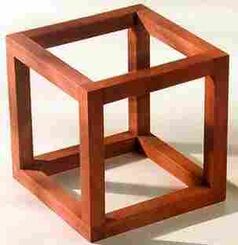
The impossible cube (or irrational cube) is an impossible object invented by M.C. Escher for Belvedere, a lithograph in which a boy seated at the foot of the building holds an impossible cube.
The impossible cube draws upon the ambiguity present in a Necker cube illustration: an impossible cube is usually rendered as a Necker cube in which the edges are apparently solid beams. This apparent solidity gives the impossible cube greater visual ambiguity than the Necker cube, which is less likely to be perceived as an impossible object.
The illusion plays on the human eye's interpretation of two-dimensional pictures as three-dimensional objects. It is possible for three-dimensional objects to have the visual appearance of the impossible cube when seen from certain angles, either by making carefully placed cuts in the supposedly solid beams or by using forced perspective, but human experience with right-angled objects makes the impossible appearance seem more likely than the reality.
Other artists than Escher, including Jos De Mey, have also made artworks featuring the impossible cube.A doctored photograph purporting to be of an impossible cube was published in the June 1966 issue of Scientific American, where it was called a "Freemish crate".An impossible cube has also been featured on an Austrian postage stamp.
